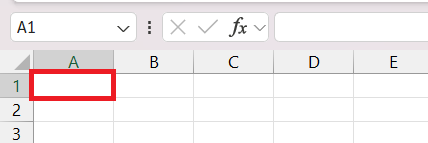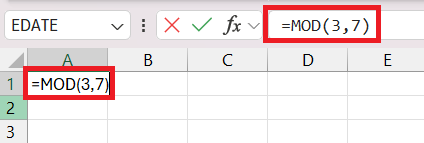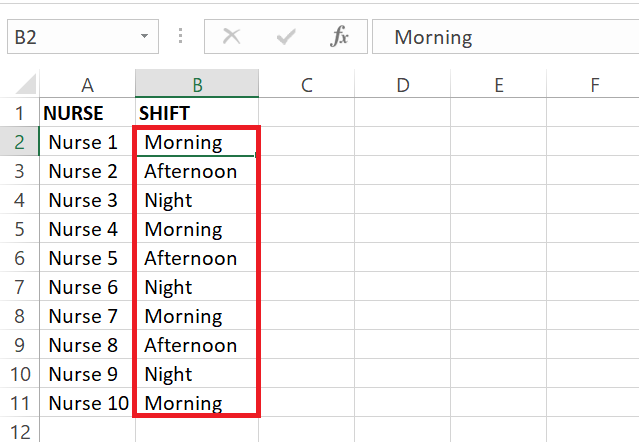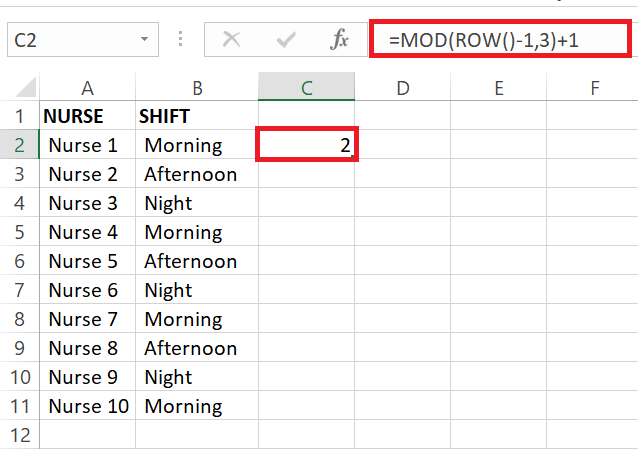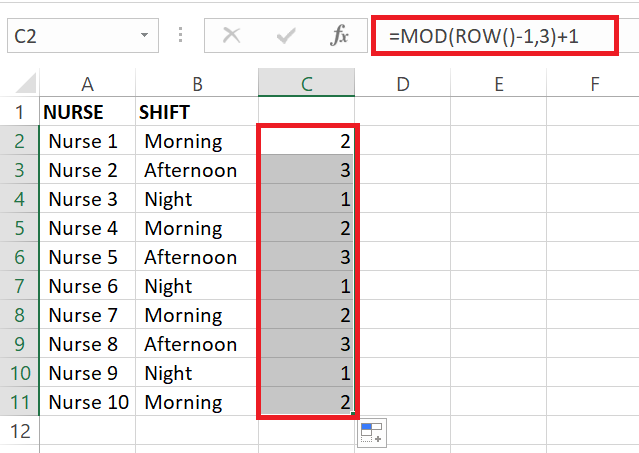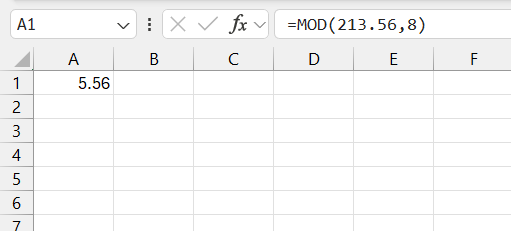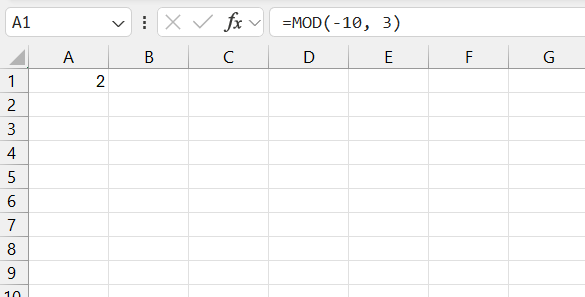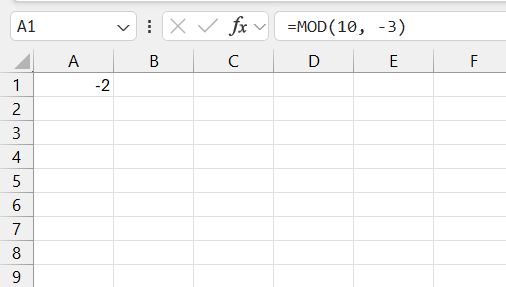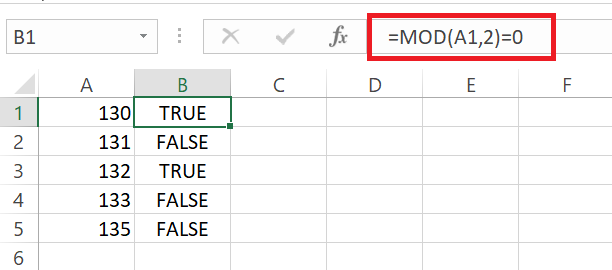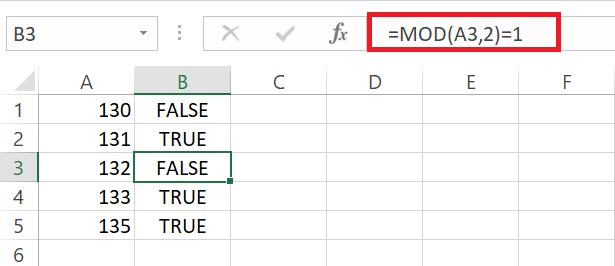Unlock the potential of Microsoft Excel‘s MOD function, a powerful tool for modulo arithmetic within your spreadsheets. Easily comprehend the basics of this function, likened to long division but with swift precision, as it efficiently calculates remainders. In this article, we will cover the method to calculate 3 mod 7 in Excel.
Key Takeaways:
- Beyond mere remainders, MOD offers a gateway to analyze patterns, manage cyclical data, and control logical flows within your spreadsheets.
- Learn the meticulous process of entering numbers correctly and interpreting results accurately, essential for various real-world applications.
- Discover how MOD facilitates scheduling, pattern identification, and invoice numbering, streamlining complex tasks with its cyclic calculations.
- Navigate challenges such as handling non-integer values and Excel’s limitations with large numbers, ensuring accurate computations and efficient workflow.
Introduction to Excel’s MOD Function
Understanding the Basics of MOD
In the realm of Excel, mastery of functions can elevate your computational capabilities, and the MOD function is one such tool you’ll find indispensable. At its core, MOD represents the operation of modulo, which might remind you of those school days filled with long division.
Imagine breaking down numbers into smaller parts: the MOD function does just that, but in a swift and precise manner, determining the remainder of a division without the hassle.
The Power of MOD for Modulo Calculations
The true excellence of MOD in Excel lies not just in obtaining remainders, but in the application of these results to analyze patterns, manage cyclical data, or control the flow of logic within your spreadsheets.
Whether you’re scheduling events or balancing complex accounts, MOD becomes your go-to function for cyclic calculations. In essence, it acts as a mathematical conveyor belt, bringing forth the residual values that are often the missing puzzle pieces in data analysis and decision-making.
Step-by-Step Guide on How to Calculate 3 Mod 7
Entering Your Numbers Correctly
To harness the functionality of the MOD function for calculations like 3 mod 7, you’ll need to enter your numbers meticulously. Do the following steps:
STEP 1: Start by selecting the cell where you want the result to appear. For our instance select cell A1.
STEP 2: Then initiate the function using the equal sign followed by MOD(.
STEP 3: Next, type in your numbers, using a comma to separate them, like so: MOD(3, 7).
STEP 4: Enter and expect Excel to divide the first number by the second divisor, so getting these the right way around is crucial for an accurate outcome.
Once you’ve pressed ‘Enter’ after inputting your MOD formula, the resulting value may hold more significance than meets the eye. Since MOD returns the remainder of a division, interpreting it correctly is vital.
For instance, when you calculate MOD(3, 7), the result is 3, because 7 goes into 3 zero times, with 3 left over.
This straightforward piece of information has various uses, such as figuring out cycles or distributing items evenly. The result basically tells you what’s left after evenly dividing the number – a concept that’s as powerful as it is elementary in solving real-world problems.
Practical Applications of Using MOD in Excel
Suppose you have a schedule where each row represents a nurse, and you want to assign each nurse to one of three shifts: morning, afternoon, or night. You can use the MOD function to cycle through the shifts for each nurse based on their row number in the schedule. Here’s how you can set it up:
STEP 1: Create your nurse schedule in row B.
STEP 2: Assign Shifts Using MOD Function: In column C (or any other empty column), enter the formula `=MOD(ROW()-1,3)+1` in cell C2.
STEP 3: Drag the formula down for all the nurses in your schedule.
Explanation of the formula: In cell C2, enter the formula: =MOD(ROW()-1,3)+1. This formula calculates the remainder when the row number (minus 1 to adjust for header row) is divided by 3, then adds 1 to the result. This will give you a sequence of 1, 2, and 3 which correspond to the Morning, Afternoon, and Night shifts, respectively. Drag this formula down from C2 to C11 to apply it to all nurses.
With this setup, each nurse in your schedule will be assigned to a specific shift based on their row number, cycling through the shifts in a repeating pattern of morning, afternoon, and night. This makes it easy to schedule nurses for three shifts a day using the MOD function in Excel.
It is similarly beneficial when seeking to identify patterns, such as assigning staff to recurring shifts or creating invoice numbers that loop after reaching a certain count.
Common Pitfalls and How to Avoid Them
Dealing with Non-Integer Values
When fractions or decimals enter the stage, the MOD function still shines by quietly rounding down non-integer values to the nearest whole number before carrying out the operation. This subtlety means you can feed it a decimal dividend without a second thought, but remember that the divisor must always be an integer to sidestep potential errors.
Taking care of this detail ensures smooth sailing through your workload without unexpected hiccups in your calculations.
Excel Handle Negative Numbers with MOD
Excel adopts a unique method for handling negative numbers in the MOD function, where the sign of the remainder corresponds to the sign of the divisor. For instance, when computing =MOD(-10, 3), Excel yields 2, reflecting the remainder that would result if -10 were incremented to the nearest multiple of 3.
Similarly, =MOD(10, -3) results in -2. While this approach may seem counterintuitive at first, it becomes intuitive with practice in your calculations.
Enhance Your Excel Skills with Further MOD Function Examples
Creating Data Validation Rules with MOD
Creating data validation rules with the MOD function can streamline your data entry process, ensuring only the right type of data makes it into your spreadsheet. For instances where you want to restrict input to even numbers only, a rule using the formula =MOD(A1,2)=0 can be set to validate the data in a flash.
Similarly, to confine the inputs to odd numbers, modify the formula to =MOD(A1,2)=1. This clever use of MOD ensures that your data stays clean, consistent, and free from human input errors.
FAQs About Excel’s MOD Function
How do you calculate MOD in Excel?
To calculate MOD in Excel, use the formula =MOD(number, divisor) where ‘number’ is the value you’re dividing and ‘divisor’ is the number by which you’re dividing. For instance, typing =MOD(10, 3) into a cell and pressing Enter will give you 1, because 10 divided by 3 is 3 with a remainder of 1. This function makes it easy to find remainders in any division operation you encounter.
How Does Excel Handle Negative Numbers with MOD?
Excel takes a distinctive approach to negative numbers in the MOD function. The sign of the remainder follows the sign of the divisor. So if you calculate =MOD(-10, 3), the result is 2 because Excel returns the remainder that would occur if -10 were increased to the next multiple of 3. Conversely, =MOD(10, -3) would give you -2. This could initially seem counterintuitive, but once you get the hang of it, it becomes second nature in your calculations.
Can You Combine MOD with Other Excel Functions?
Absolutely! MOD is exceptionally versatile and when mixed with other Excel functions, it opens up a world of possibilities. Merge it with IF to create conditional formulas, or with SUMIF for selective adding based on a pattern. Combining it with ROW and COLUMN functions can help in highlighting alternate rows or columns, and integrating it with VLOOKUP can determine if lookup values meet certain modular criteria. The horizon is broad with MOD, allowing you to customize formulas to fit your specific data needs.
What Are the Alternatives to the MOD Function When Dealing with Time Values?
When time values are your focus, the MOD function can be helpful, but there are alternatives. For instance, the INT function can extract just the date portion by rounding down to the nearest whole number, and the HOUR, MINUTE, and SECOND functions can tease out specific components of time. These functions can sometimes provide more direct clarity for time-related calculations than MOD, which may require additional steps to isolate time values from datetime numbers.
What is the value of mod 11 3 in MS Excel?
In MS Excel, when you want to find the value of 11 mod 3, you’d use the formula =MOD(11, 3). After entering this formula into a cell, Excel will display the value ‘2’. This is because 11 divided by 3 equals 3 with a remainder of 2. The MOD function simplifies finding this modulus value, which is the remainder after division.
John Michaloudis is a former accountant and finance analyst at General Electric, a Microsoft MVP since 2020, an Amazon #1 bestselling author of 4 Microsoft Excel books and teacher of Microsoft Excel & Office over at his flagship MyExcelOnline Academy Online Course.

